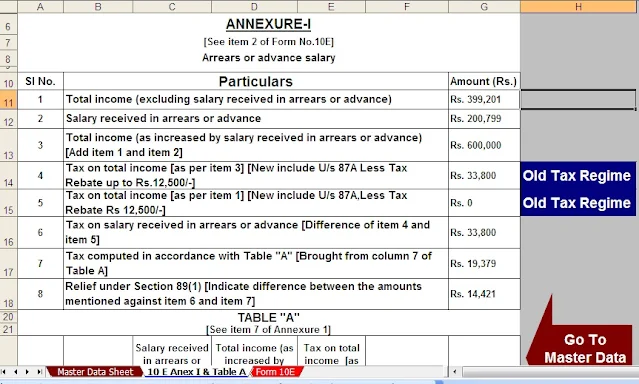What is Section 89?
Download Automatic Arrears Relief Calculator U/s 89(1) with Form 10 E | For the purposes of the Income Tax
Law, income tax is levied on the total income earned or received during the
previous year by the taxable person. There are cases when past debts are paid
to an employee in the current year as salary arrears. In this case, the income
tax payable by the employee will in this case be higher in the current year.
This may be due to a change in the flat rate applicable to the taxpayer, in
connection with which his flat rate will change to a higher tax rate.
The Section 89 tax credit allows us
to deal with this situation. Provides for an exemption if the employee is in a
higher tax bracket at the time of receiving money for previous years.
How to calculate the tax exemption
under section 89(1) for wage arrears?
Below are the detailed steps for
calculating Section 89 assistance:
Step 1: We need to calculate the
tax due on all income, including income owed in the year it was received.
Step 2: Calculate the tax payable
on total income, excluding income owed in the year of receipt. As evidence, the
employer provides the employee with an overdue document, which will indicate
the additional amount received. This amount must be deducted from the total
salary as stated on the worker's Form 16. The calculation of the tax would give
us responsibility in case there were no delays.
Step 3: Calculate the difference
between steps 1 and 2. This will be the additional payroll tax included in your
total income.
Step 4: Calculate the tax payable
for each previous year to which additional delays apply:
By total income, including
additional debt
By total income without additional
debt
Step 5: Calculate the sum of the
difference between the amount calculated in step 4. This will calculate the
actual tax liability for any previous years for which arrears were received in
the current year.
Step 6: The amount in excess of step 3 over step 5 will be the amount of the tax exemption allowed by section 89. If there is no excess, no exemption is allowed. If the tax calculated in step 3 is less than the tax calculated in step 5, the employee does not need to apply for an exemption under section 89.




